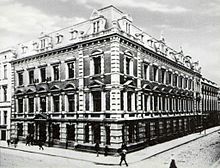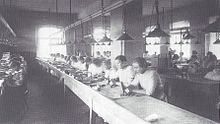State amber factory in Königsberg
The Staatliche Bernstein-Manufaktur Königsberg (SBM) with its seat in Königsberg (East Prussia) was founded in 1926 with significant participation of Preussag AG and initially operated as "Staatliche Bernstein-Manufaktur GmbH". The company existed until 1945 and at times employed up to 1,500 people. It was the largest amber factory in the world at its time.
history

The SBM, founded in 1926, emerged from a merger of the “Bernsteinwerke Königsberg i. Pr. ”And its subsidiary, Hugo Barth GmbH in Danzig, with the amber processing companies Gompelsohn & Co. (Danzig), W. Witzki (Danzig), HL Perlbach (Königsberg) and M. Weidt (Berlin). Preussag had the greatest weight in this merger with its subsidiary Hugo Barth GmbH, which was held through the Bernsteinwerke Königsberg branch, so that Preussag already held a majority stake in SBM when it was founded. She expanded this in the following years until she was finally the sole owner of the company in 1929. From 1936 the SBM was a branch of the Bernsteinwerke Königsberg. The company was retained until 1938 and was then changed to the “Königsberg branch”. After the end of the Second World War, Preussag became the company's legal successor. Amber processing was given up in 1945. In the last months of the war, in connection with the bombing of industrial plants in the interior of Germany, the equipment of some production facilities for rifles and cartridges was relocated to the facilities of the amber factory, while at the same time the amber production machines were outsourced.
The Kaliningrad Amber Combine, which mines and processes amber in the Kaliningrad Oblast today , used some properties and the partly still existing equipment of the former state amber factory in the early years of its operational activity after the Second World War, but is not the legal successor of the Königsberg factory. The factory building was still used temporarily by the Soviet army as accommodation in the post-war period. Then the building fell into disrepair. In 2013 the city and the Kaliningrad Oblast presented plans to renovate the building and make it usable for exhibitions of the Maritime Museum and the Kaliningrad Amber Museum.
The economic background to the business combination in 1926 was the development of the amber market in the period after the First World War, which led to falling revenues. This included the emergence of synthetic resins, which increasingly took the place of natural and pressed amber. In the first quarter of the 20th century, the high-turnover cigarette and pipe tips, mostly made of pressed amber, were increasingly being replaced by products made of Bakelite . Another problem was the temporary overproduction of raw amber. In the Samland , up to 500 tons were extracted annually in the 1920s. Large stocks and an oversupply of amber items led to a drop in prices. Further economic difficulties arose after the outbreak of the global economic crisis in 1929, which led to a dramatic shortage of foreign currency in many countries, so that the export of raw amber and amber articles also declined. In order to promote the sale of amber articles, the SBM set up branches in various European countries and in the United States of America in the late 1920s and early 1930s.
The SBM had a kind of monopoly on buying beach finds. According to a legal system enacted in 1932 and valid in East Prussia, which is to be regarded as the last chapter in the history of the amber shelf, which has existed since the Middle Ages , all amber found was to the "... responsible amber buyers of the amber works or to them directly to Königsberg Pr., Sattlergasse No. 6 ... “to be delivered. The finder was paid the current list price by the SBM, which was involved in the aforementioned "amber works". Although the quantities purchased from Strandlese were quite considerable before and after this regulation came into force (e.g. more than 50 tons in 1929; for comparison: extraction from the Kraxtepellen open-cast mine in the same year 464 tons), the company's special position was due to its economic development of minor importance.
Products
As a result of the company merger, there was a lively development in craft and craft amber processing. The word of “good and beautiful form” made the rounds among the artisans at SBM. In fact, the company's artistic consultants have often succeeded in giving jewelry and everyday objects a new aesthetic. Names like Hermann Brachert and Jan Holschuh , along with many others, stand for this development. Religious objects and amber figures were also created. Some of these objects were bought by museums or have remained in the possession of Preussag (today TUI).
In addition to amber jewelry and everyday objects made of amber, products were also created that reflect the political influence of the National Socialists. This included sports trophies and badges of honor. Up to 2,600 women were employed in addition to the permanent staff for the production of badges for the winter relief organization alone . The efforts of the political rulers to convince their citizens to purchase amber articles for patriotic reasons, however, did not lead to a revival of sales.
During the Second World War, on behalf of the Reichswehr Ministry, the company produced a resin mass obtained from amber waste, which was part of an irritant gas used in closed rooms (Stoltzenberg stimulus cube), with which the secure fit of gas masks was checked. The production of non-war products decreased significantly during this period.
Some handicrafts from the SBM can be seen in public exhibitions today, including in the East Prussian State Museum in Lüneburg and in the East Prussian cultural center in the Ellingen residence ( Middle Franconia ). The Kaliningrad Amber Museum has completely dedicated one of its exhibition rooms to the SBM. The extensive in-house amber collection of the SBM, which was shown in Turkey at the end of the Second World War and thus remained intact, is now in the care of the German Amber Museum in Ribnitz-Damgarten .
See also
literature
- Ulf Erichson (eds.) & Leonhard Tomczyk: The State Amber Manufactory Königsberg 1926–1945. Ribnitz-Damgarten 1998. (main source of this article)
Individual evidence
- ^ A. Kossert: East Prussia - History and Myth. Munich 2007.
- ↑ ZV Kostyashova: The history of the Kaliningrad Amber Factory. Kaliningrad 2007
- ↑ Königsberger Express 1/2013, p. 12 f.
- ↑ K. Andrée (Ed.): Bernsteinforschungen. Issue 2, Berlin and Leipzig 1931.
- ↑ F. Schmaltz: Warfare agent research in National Socialism. Göttingen 2005.
- ^ U. Erichson: The amber collection of the TUI AG Hanover. In: Bernstein in the work of Hermann Brachert. Kaliningrad 2015. ISBN 978-5-903920-34-1



